
Gay Pride Week’s well underway here in NYC. While most gays are out in full force, there’s a queer constituency who aren’t swinging from the rafters. Actually, more than a few. Since the days of the very first pride – and, in fact, Stonewall itself – there have been tensions between the movement’s ideological factions.
Gay Pride’s revolutionary message may have been white-washed years ago, but some gays never stopped queering it up to oppose Pride’s mainstream, commercialized tendencies.
As we discussed yesterday, the Gay Liberation Front counts as the first post-Stonewall gay group. Revolutionary through and through, the Front forged ties with other “radical” social groups, including the black panthers. They sought nothing less than a complete cultural, political and social revolution to dismantle heterosexism’s oppressive institutions. Unfortunately, some GLF members weren’t down with the gang’s militant slant.
Thus, in December, 1969, a number of moderate activist founded the Gay Activist Association. These activists helped pave the way for a number of today’s gay-friendly legislation, including non-discrimination laws. Weakened and ineffective, Gay Liberation Front folded a few years later. Their spirit, however, lived on.
Though without an international organization to guide them, revolutionary gays continued to participate in gay pride, which had yet to be produced by more commercially-inclined organizations. As the 1970’s tore on, however, the once-radical movement closer to the mainstream. Gays didn’t need to employ radical politics. They could just join their former foes. David Eisenbach writes in Gay Power, “In another sign of the changing times, open homosexuals were gaining political influence not by zapping politicians, but by running for office themselves (267).” The most visible gay activists worked hard to define themselves as a minority group deserving of American civil rights.
How about we take this to the next level?
Our newsletter is like a refreshing cocktail (or mocktail) of LGBTQ+ entertainment and pop culture, served up with a side of eye-candy.
Internal discrimination also weakened the movement, however. Trans rights took second place to “gay” rights, which existed within standard, pre-gendered political and legislative boundaries. Effeminate men and butch women often found their voices suppressed as more public friendly images of gays were circulated. Not surprisingly, this didn’t sit well with a minority of the so-called minority and hundreds of gays, lesbians and trannies split off to form their own organizations or simply disappear from the activist scene.

The AIDS crisis only exasperated exacerbated preexisting problems. While ACT-UP and GMHC boasted diverse memberships, the gay pride movement swung in a decidedly centrist direction. Gays could no longer afford to be seen as “queer”. Many ‘mos, however, refused to be called “gay”.
In 1985, Bruce LaBruce and GB Jones made history when they first published JD’s. The juvenile delinquents refused to root themselves in the gay scene and made a show of rejecting the majority’s commercial slant.

In their manifesto, they wrote:
Sex. The final frontier.
This is the voyage of JDs, its continuing mission: to seek out and destroy outdated ideas about sex.
What are you? Gay or something? What do you think Sid and Johnny were doing before Nancy? And, like, haven’t you ever heard of the Buzzcocks? And what were you doing when Dee Dee Ramone was giving head on 42nd Street? And Phranc was in Nervous Gender? OK, now it’s the Nip Drivers – Quentin Crisp; Mighty Sphincter – Fag Bar; Victims Family – Homophobia. This is the J.D.s Top Ten today. Get with it.
…
If you’re fighting against how the majority tells you to act, then how can you act like the majority when it comes to sex-type-stuff?… Who says girls can’t be butch? Who says boys can’t be fags?J.D.s is the homocore movement.
Born from the hardcore music movement, homocore hoped to derail their not-so-queer comrades. In fact, the movement would later accommodate sexual diversity by changing its name to “queercore,” thus truly rejecting the heterosexist prescriptions to which the gay pride movement subscribed.
LaBruce explains Queercore’s origin:
When I started out forging my career as a homosexual in the early eighties, I found the gay scene already to be stagnant and boring, both aesthetically and politically. It just didn’t have the revolutionary impetus of its early roots. So I turned to punk, which seemed really rebellious and fresh and stimulating and politically radical. The early roots of punk were also sexually rebellious, experimenting with androgyny, promiscuity, bisexuality and homosexuality.
Unfortunately, by the mid-eighties, a certain sexual conservatism had seeped into the scene as punk already started to burn itself out… Hardcore, which was characterised by faster, more aggressive music and the violent mosh pit, had taken over, and with it a more macho stance. This was good for sexual fetishizing, but ushered in a less tolerant attitude toward homosexuality. I was starting to get beat up at hardcore shows for showing gay-themed movies and for dressing like a faggoty fag.
Homocore and its fanzines and bands were a response to the ineffectual, assimilationist direction of the gay movement, and to the homophobia of hardcore.
Queercore enjoyed a slow, steady growth during the 1980’s, but much of its energies were focused on DIY art. A number of organizations, including Queer Nation, would embrace their rebranded revolutionary direction. The foundation for gay shame had been laid.

Like ACT-UP, the GLF and the GAA, Queer Nation staged a number of direct action campaigns against what they called an oppressive society. They took a firm stand against moderate groups such as Human Rights Campaign and fought for universal human rights, not just “gay rights”. Their 1990 manifesto reads:
Being queer is not about a right to privacy; it is about the freedom to be public, to just be who we are. It means everyday fighting oppression; homophobia, racism, misogyny, the bigotry of religious hypocrites and our own self-hatred. (We have been carefully taught to hate ourselves.) And now of course it means fighting a virus as well, and all those homo-haters who are using AIDS to wipe us off the face of the earth. Being queer means leading a different sort of life. It’s not about the mainstream, profit-margins, patriotism, patriarchy or being assimilated. It’s not about executive directors, privilege and elitism. It’s about being on the margins, defining ourselves; it’s about gender- fuck and secrets, what’s beneath the belt and deep inside the heart; it’s about the night. Being queer is “grass roots” because we know that everyone of us, every body, every cunt, every heart and ass and dick is a world of pleasure waiting to be explored. Everyone of us is a world of infinite possibility. We are an army because we have to be.
…
Let’s make every space a Lesbian and Gay space. Every street a part of our sexual geography. A city of yearning and then total satisfaction. A city and a country where we can be safe and free and more. We must look at our lives and see what’s best in them, see what is queer and what is straight and let that straight chaff fall away!
Unfortunately for Queer Nation and their ideological adherents, the mainstream movement had picked up too much steam. Though some chapters continue to operate, Queer Nation’s largely disbanded.
Queer Nation, the GLF, Act-Up and the other rebellious organizations laid the groundwork for the formation of two new groups in the late 1990’s. Fed Up Queers, a short-lived yet influential action group, used the post-Mathew Shephard political environment to protest the “normalization and acceptance” of the queer community. In That’s Revolting: Queer Strategies for Resisting Assimilation, FUQ member Eustacia Smith explains:
Fed Up Queers sought to up the ante of the status quo of activism by pushing the limited whenever possible, wherever possible, though acts of civil disobedience and covert actions… Our intention was to be powerful, edgy, sexy and subversive, pushing the gay cultural norms wherever possible, and to do this through actions, not through dialogue and process (219).
FUQ disavowed moving for marriage, adoption and other mainstream rights. Rather, they sought to disrupt HRC and other domesticated gay groups.

1998 also saw the founding of Gay Shame, a movement dedicated to counteracting the increasingly commercialized Gay Pride. From the group’s website:
Gay Shame is a Virus in the System. We are committed to a queer extravaganza that brings direct action to astounding levels of theatricality. We will not be satisfied with a commercialized gay identity that denies the intrinsic links between queer struggle and challenging power. We seek nothing less than a new queer activism that foregrounds race, class, gender and sexuality, to counter the self-serving “values” of gay consumerism and the increasingly hypocritical left. We are dedicated to fighting the rabid assimilationist monster with a devastating mobilization of queer brilliance. Gay Shame is a celebration of resistance: all are welcome.
The first Gay Shame started here in New York as an artist’s collective. Like their predecessors, such as Queercore, the shamers also published a ‘zine, Swallow Your Pride, in which activists lambasted the mainstream ‘mos and their marriage commitments.
The movement quickly spread across the nation, with the most active group coalescing in San Francisco, the last city to drop “Gay Freedom Day Parade” and adopt The Gay Pride Parade. A non-hierarchal consensus-based group, the shamers eschew personal identity – referring to each other as “Mary” – and believe that all queers must have a voice in the political battle. Since their founding, Gay Shame’s organized a number of political protests, including a protest at San Francisco Mayor Gavin Newsom’s inauguration and frequent demonstrations against marriage bills.

As gays gain more rights, however, some gay activists claim Gay Shame and similar organizations hinder our homo-growth. While that may be true, had it not been for such groups, we wouldn’t have gay pride. The Stonewallers weren’t about to lay down their weapons for the remaining scraps of democracy. The Rebellion’s inherent revolutionary ideology must be maintained. The fight for equal rights, however, must also be maintained. So, how can a gay, dyke, queer, trans or whomever honor both the radicalism and America’s essential freedoms? By ensuring that all people are included in the fight. We’re talking black, white, poor, rich, homeless, trans, hookers, every type of person under the gay rainbow must be a part of the decision making process. There cannot be a gay movement without the queers. The queers, too, can’t make great headway without the gay movement.
Can their be compromise between the opposition parties? Can there really be one idyllic queer community? We haven’t the foggiest, but we’re sure as hell hoping no one gets left out in the cold. And the only way that can be insured is by honoring both gay pride and gay shame.

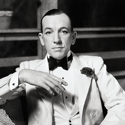
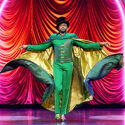


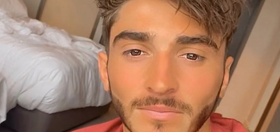
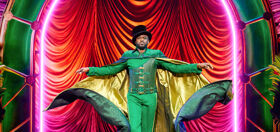







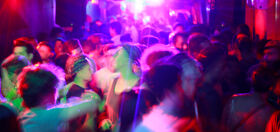
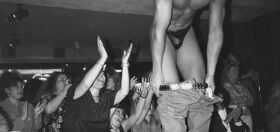

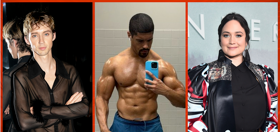
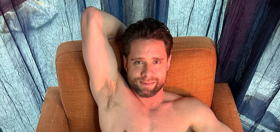
Lamb Cannon
What, they don’t want to eat, shit, and sleep the LOGO channel, flirt with other losers on Manhunt, help promote the worst music in the history of the human race?
SHAME, SHAME!
nycstudman
Give me a fucking break. You’re talking about, at best, a few hundred people who stand on the sidelines bitching about – hey, let me quote the witty response from Lamb Cannon — “the LOGO channel, flirt with other losers on Manhunt, help promote the worst music in the history of the human race” — in other words, all the stupid cliches we’ve allowed others to impose on us, “Amos & Andy” style.
Typical of your “history”: “he AIDS crisis only exasperated preexisting problems.” That’s like discussing the Zionist movement in pre-War Poland and saying “The Holocaust only exacerbated [that’s the word you meant; do you people own a fucking DICITONARY?] pre-existing problems.”
hisurfer
At the risk of exacerbating the dialogue, I think I agree with the exasperated nycstudman on this one. I liked the first half of your Pride history quite a bit, but you guys lost me on Part 2. ACT-UP gets part of a sentence, while “jd” (which I’ve never heard of) and Queer Shame (ditto) get an extensive write-up. I was part of Queer Nation, but I’m not sure how we – or any of these – impacted Pride parades.
But I’m a bad fag these days, and started skipping the parades long ago – not so much for political reasons as because Pride parades bored me senseless. I still like the parties (and Manhunt, and that horrible music that makes LambCannon suffer so), so I’m not sure if I’m still allowed to be “queer”.
gaypersonsofcolor
I guess one good thing is that gay society as a whole has reached a level of maturity at which a diversity of voices are represented. Still, a lot of work needs to be done for pride events to be truly representative of gays everywhere, that is, if one thinks pride events are relevant…
Bryan
Very well written I must say.
larrybob
I applaud your recognition of queer counterculture, but I don’t think that ultimately it has made much difference to the rushing torrent of the much more powerful commercial gay world. I found out about JDs and another early queer zine, Homocore in 1988 from a writeup in Adam Block’s column on rock music in the Advocate. I started doing my own zine, Holy Titclamps shortly thereafter. For over a decade I published that zine and Queer Zine Explosion, a review zine. I reviewed literally hundreds of queer zines. The zine movement died down a great deal after the internet made communication with people of non-mainstream interests easier.
People have asked me what impact queer zines have had on the gay mainstream, and I have to say honestly, very little. Sure, people who initially produced zines have gone on to have books published (Michelle Tea) or made movies (Bruce LaBruce) or been in bands that are critical darlings (Donna Dresch of Team Dresch.) But the mainstream has not changed much.
Cultural complacency of any sort is saddening — people who have accepted mainstream crap, whether it’s music or political agendas — however I’m resigned that it’s here to stay, at least until society as a whole collapses under its own unsustainability.
Jimmi
@Lamb Cannon: APPLAUSE! THANK YOU!